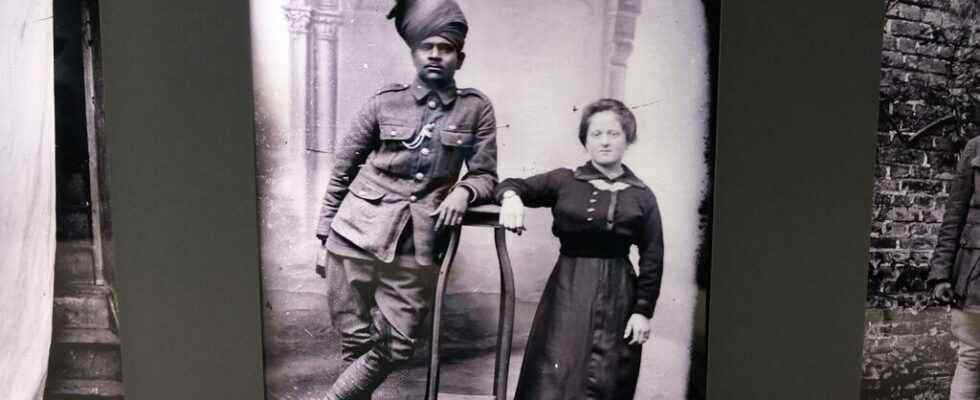In 1914-1918, the village of Vignacourt, in the Somme, was an important rear base for Allied soldiers. A couple, passionate about photography, left a real treasure, testifying to life behind the front line. A treasure that almost fell into oblivion, since it was only found a century later, in the attic of their farm.
From our special correspondent in Vignacourt,
The portraits are striking. We see Australian, Canadian, Scottish, Nepalese, Senegalese soldiers… Some have serious, closed faces, where you can read the horror of war. Others have a slight smile on the corner of their lips. Eyes planted in the lens of the Thuillier couple.
During the Great War, Antoinette and Louis Thuillier set up a real photo studio, something rare at the time, on their farm, located in the heart of the village of Vignacourt, in the Somme (northern France). Louis, wounded in the war, is passionate about novelties, and teaches his wife to use his plate camera. In the improvised studio, both immortalize those who wish, at low cost. Dozens and dozens of soldiers march past their objective. They use the photos as postcards to send news to their families.
In front of the lens, there are also civilians, women and children, or workers, inhabitants of Vignacourt, mingling with the soldiers. In total, the couple takes more than 4000 photographic plates. ” The quality of the photos is incredible, you can zoom in on the soldiers’ clothes, and clearly see their battalion number, for example », explains Valérie Vasseur, the head of the Vignacourt Interpretation Center 14-18.
A discovery almost a century later
The museum was created in the former Thuillier farm in 2018. Because the photographic treasure was only discovered very late, almost a century after the war. “ They could have been forgotten, but thanks to enthusiasts and a good dose of luck, they were found “says Valérie Vasseur.
Once the armistice is signed, the soldiers leave Vignacourt. The couple is forced to stop the photo. Louis Thuillier saw it badly, fell into depression, and committed suicide in 1931. The photographic plates were then stored in large trunks, in the attic, far from the eyes of Antoinette and her son Robert, who were trying to survive the tragedy.
In 1988, the then mayor baptized two streets in the village to honor the memory of the Australians who came to fight on his land. An exhibition is organized for the event, and Robert Thuillier asks a photographer friend to develop some photos of his parents. Photos that will remain hanging in the town hall.
In 1990, an amateur historian passing through the village discovered them. Convinced that he has an exceptional testimony there, he begins research to find other photos. In 1996, the Thuillier’s son died, and the farm was put up for sale. It will remain without a buyer for nearly 20 years.
Australian television films the discovery
In 2011, the research of the amateur historian reached the ears of Australian television, Seven Network. In the Somme, 11,000 Australian soldiers died during the Great War, the country therefore cultivates an important duty of remembrance. When the channel’s journalists landed in Vignacourt, they obtained permission from the Thuilliers’ granddaughter to enter the abandoned farm. In the attic, they discover enormous dusty trunks, and the 4,000 photographic plates, almost intact.
A wealthy Australian businessman buys these plates and they are loaned to theAustralian Memorial War. A long research work then begins, to name the soldiers and find their descendants. Australians create a Facebook page, The lost Diggers, where they publish all the photos and appeal to families. ” To date, 230 soldiers have been identifiedexplains Valérie Vasseur, a job that we also do here in Vignacourt, recently we appointed 26 soldiers. »
Before the Covid, their descendants came to the museum to walk in the footsteps of their ancestors, “ it is very important for them, they immerse themselves in the places, and these are always moving visits “.
Testimony from the rear
In the center of Vignacourt, photos have been printed and exhibited, but it is also possible to access the entire collection digitally, via a tablet. Each shot is a testimony to life in the rear, and the importance for soldiers to rest, and enjoy far from the fighting. ” We see in particular Australian soldiers having a boxing match, playing cricket or even theater evenings, with a soldier dressed as Pierroyou”.
The Thuilliers also took pictures of Chinese workers who had come to participate in the war effort. “ You should know that the whole world came to this small village, where the inhabitants had never gone further than Amienssmiles the head of the center, there are Nepalese, Indians, Chinese, Senegalese, Moroccans, etc. »
This photographic treasure thus makes it possible to tell History, thanks to small stories. This particularly affects the head of the center. Because on one of the photos found, there is a shot of his grandmother, posing with Indians.
